This week we consider Bitcoin’s ROI in the current cycle, as well as economic and regulatory events that can influence crypto. Also, Immutable celebrates good news, Binance implements a new tool, while Fidelity prepares to launch its stablecoin.
Let’s dive in.
Bitcoin shows 560% ROI in the current cycle
With Bitcoin’s maturity has come stable growth, as explosive returns have given way with time. The latest cycle has shown a 560% return on investment (ROI) as BTC exceeds traditional assets, making it appealing to long-term investors.
Bitcoin’s ROI has always followed a clear downtrend with each halving cycle. From a massive 4,830,000% gain in 2009-2011 to 55,000% in 2011-2015, 8.500% in 2015-2018, and 2,000% during 2018-2022. The current cycle (2022-2025) shows a 560% ROI, reinforcing a steady pattern of diminishing returns.
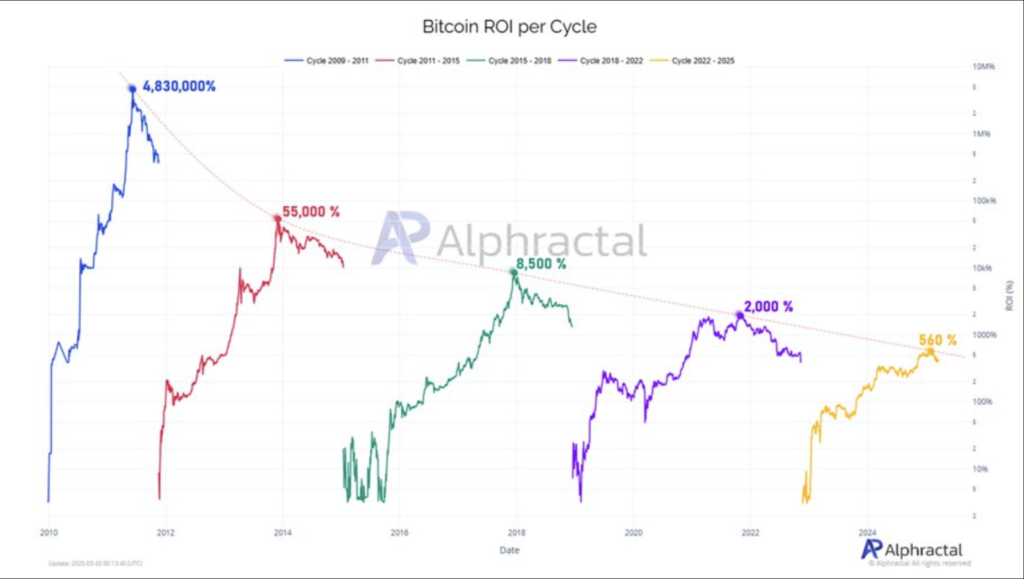
The decreasing ROI arc reflects the asset’s increasing liquidity, institutional adoption, and reduced speculations.
Sentiment data from large Bitcoin holders indicate a shift in positioning. The whale position sentiment index has decreased after peaking, displaying an increasing preference for short positions.
Historically, sharp downturns in this metric have preceded either short-term pullbacks or high-volatility price zones. Similarly, the change in sentiment does not always indicate a trend reversal, but it emphasizes a decrease in confidence among influential market participants.
In a maturing market, such behavior shows the growing influence of derivative markets on price psychology and near-term volatility.
BTC’s whale returns after 8 years with $250m
Bitcoin whales are in the news again, this time with dormant wallets reawakening and massive transactions impacting on-chain dynamics.
One whale recently withdrew 2,400 BTC (worth over $200 million) from Binance. The purchase came after months of strategic selling during which the whale offloaded 11,400 BTC before re-entering the market.
Despite reducing its holdings in February when BTC fluctuated between $100,000 and $86,000, the whale has now increased its position to over 15,000 BTC, valued at an estimated $1.3 billion.
The timing now aligns with Bitcoin’s price rebound, which has seen BTC trading between $81,000 and $88,000 over the past week.

While some whales are actively accumulating, others are resurfacing after years of dormancy. On March 22, an address that had been inactive for eight years suddenly moved 3,000 BTC (worth an estimated $250 million) in a single transaction.
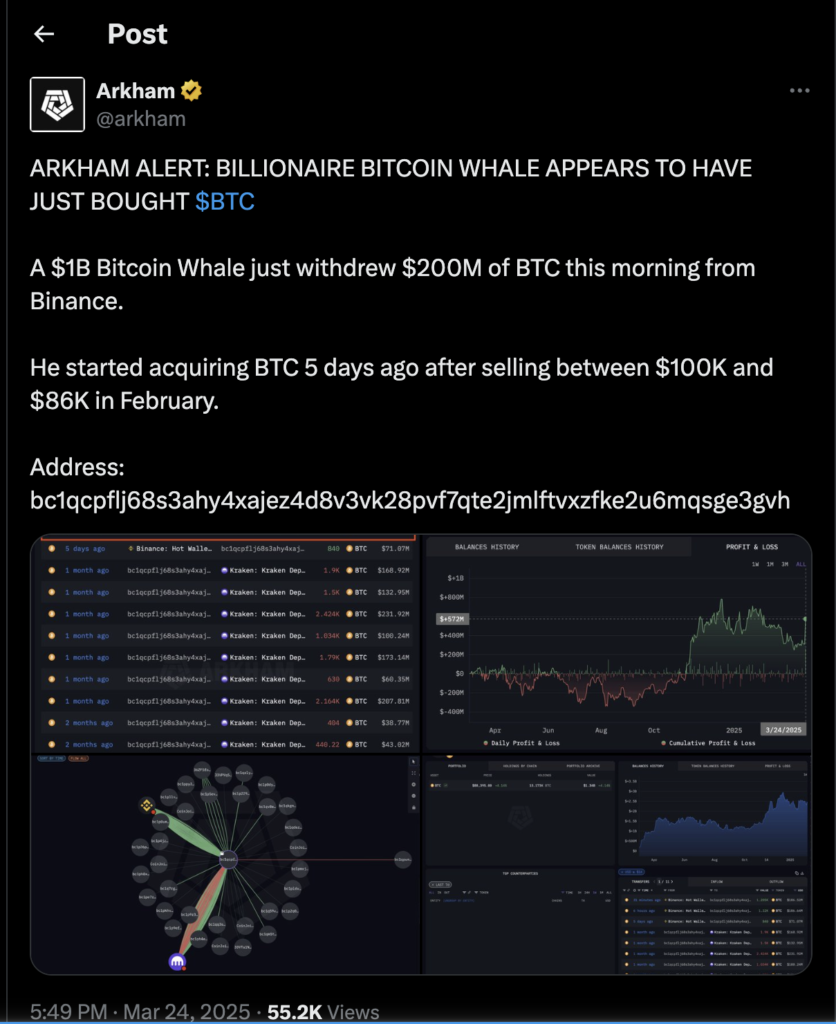
It was noted that the whale initially acquired its BTC stack when it was worth just $3 million in early 2017, making this an astronomical gain.
BTC 172k acquisition could trigger a bullish trend
The acquisition of over 172,705 BTC since February 23rd indicates a significant shift in market dynamics. This increase in demand is similar to the aftermath of the FTX collapse when the market reached its bottom.
New investor interest is rising steadily, which could imply an essential turning point for BTC. Thus, this accumulation phase will likely push BTC’s price upward, possibly leading to a new bullish market phase.
According to CryptoQuant data, BTC’s address activity has grown significantly. Active addresses have increased by 0.96%, reaching 8.72 million. This increase highlights growing user engagement and reflects significant interest in BTC from retail and institutional investors.
In addition, transaction counts have advanced by 1.66%, totalling 498.79k transactions. This increase in transactions emphasizes strong demand for BTC, which could drive an upward price movement.
These positive metrics imply robust network activity, further supporting the possibility of a price rally.
The combined factors of increased Bitcoin acquisitions, growing network activity, and technical breakout potential indicate that BTC is nearing a bullish phase.
With new investors fueling demand and technical indicators implying a breakout, BTC appears ready for near-term growth. The recent surge in acquisitions suggests that BTC could reach new highs.
SEC ends investigation into Immutable
The U.S. SEC has ended its investigation into the Ethereum-based gaming project Immutable without enacting any punishment.
The regulator had earlier launched its probe into Immutable’s IMX token in October 2024 with a Wells Notice. But it called it off five months later after finding no evidence of wrongdoing.
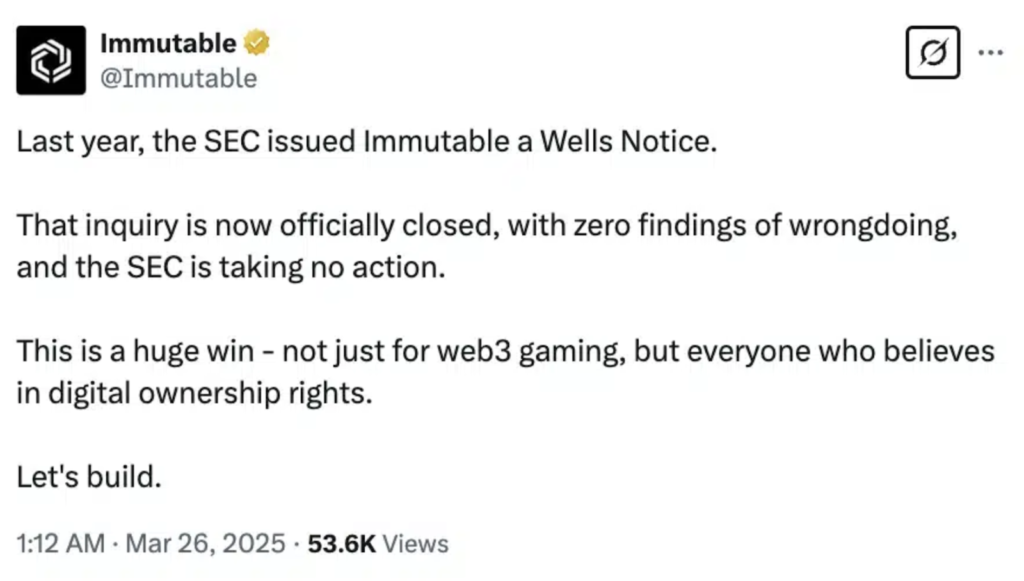
Naturally, Immutable has been in celebratory mood with its co-founder and president, Robbie Ferguson stating,
“We are pleased the SEC has concluded its inquiry. This marks a significant milestone for the crypto industry and gaming as we advance towards a future with regulatory clarity.”
Ferguson further outlined Immutable’s enthusiasm for the government’s increasing regulatory clarity, championing its positive impact on the industry. He said,
“With a clear regulatory framework, we plan to accelerate our ambitions to bring digital ownership to the 3.1 billion gamers in the world.”
SEC’s change in approach
This marks the latest activity in the change of approach by the SEC towards the crypto market. The regulator has evolved from its previous style under former Chair Gary Gensler.
In less than three months since President Donald Trump assumed office, the SEC has eased its aggressive stance. With Acting Chair Mark Uyeda now at the helm, the agency is actively redefining its regulatory strategy.
First, a Crypto Task Force, led by pro-crypto Commissioner Hester Peirce has also been formed to focus on oversight. Secondly, the SEC has formulated industry roundtable discussions to encourage the development of more effective frameworks.
To that end, the agency has ended investigations into notable platforms like Gemini, OpenSea, Yuga Labs, Robinhood without filing enforcement actions. It also dismissed lawsuits against industry players like Kraken, Coinbase and ConsenSys, while pausing ongoing cases against Tron and Binance.
5 US Economic events to influence crypto this week
Here, we consider several US economic data releases that will generally influence BTC and crypto market sentiment:

Services and Manufacturing PMI
Strong manufacturing and service PMI readings could boost risk appetite, lifting BTC as investors seek high-yield assets. On the other hand, readings below 50 would signal economic contraction, stoking recession fears and driving flows away from crypto.
Consumer Confidence
Despite solid job growth, February’s drop to 98.3 hints at unease. A rebound to the median forecast 95.0 could signal warning retail optimism, a key driver for Bitcoin’s retail-heavy market, pushing prices higher. However, Federal Reserve expectations might grow if confidence drops, providing mixed outcomes.
Initial Job Claims
The Initial Jobless Claims report will track labor market strength, showing the number of US citizens filing for unemployment insurance. Higher claims could spark recession fears, prompting investors toward BTC as a hedge against instability. Conversely, lower claims bolster traditional markets.
GDP
The GDP second revision for Q4 2024, out on Thursday, is predicted to be 2.3%. More substantial growth could affect BTC’s appeal as a risk asset if investors favor equities, especially with revised 2024 figures showing a 3% annual rise. A weaker print might reinforce rate-cut speculation, improving BTC’s allure as a store of value.
PCE Index
A hotter-than-anticipated core PCE (Personal Consumption Expenditures) could delay rate cuts, pressuring BTC downward as tighter policy looms. A softer reading could lead to a rally, galvanizing hopes of monetary easing. With inflation stickiness remaining, this release could explain BTC’s near-term trajectory.
Binance implements secondary listing model
Rather than directly listing tokens on the Binance exchange as done before, Binance has recently utilized a new method through Binance Wallet.
Similarly, the exchange has moved from large-scale initial token offerings to a secondary listing model after hosting Token Generation Events (TGEs) through Binance Wallet.
So far this year, five projects have been publicly launched on Binance Wallet. It facilitated the sales of projects, including Particle Network (PARTI), Bedrock (BR), and Bubblemaps (BMT).
It seems that Binance is reducing the direct listing of projects it considers to have potential. Instead, it is employing a secondary listing model through other components within its ecosystem.
It is vital to note that Binance does not list the tokens immediately after the TGE phase even with the selling pressure. Instead, it enables users to sell first on Binance Wallet, PancakeSwap, or other centralized exchanges (CEXs). This ensures that Binance users who did not partake in the TGE are not affected by price drops.
Ultimately, Binance can list the token when its valuation is less, and selling pressure has declined. Projects with strong capital may have already re-bought their tokens at a low price, and at this point, the listing can lead to a new wave of price increases.
The notable performance of these projects after TGE triggers a FOMO (Fear of Missing Out) effect, leading to multiple benefits to Binance’s ecosystem. This includes increasing the Total Value Locked (TVL) on the BNB Chain as new assets are issued, adding new users to the Binance Wallet, and pushing demand for BNB purchases.
Different users have aired their thoughts on X (formerly Twitter).
One user observed that “Binance has pivoted away from doing huge initial launches with big Day-1 selling pressure, while doing more secondary listings shortly after running the TGE campaign on Binance Wallet.”
Another commented that the token sale on Binance Wallet is part of a 4-stage strategy for new projects. They noted that the ultimate goal of this strategy is to list on Binance Futures and eventually aim for a Binance Spot listing.
How has Binance Wallet fared so far?
Due to the secondary listing model, projects conducting TGEs through Binance Wallet have exhibited exceptional performance. Data from icoanalytics indicates that all five projects launched via Binance Wallet in 2025 have achieved ROI ranging from 2.3x to 14.7x, outperforming projects on Binance Alpha.
This strategy has effectively lessened users’ risk and optimized the benefits for binance ecosystem components, including BNB Chain and Wallet. Due to this, Binance Wallet’s daily trading volume surged by a 24x increase from early March.
However, users on other CEXs may experience losses due to initial selling pressure. Additionally, if a project fails to develop successfully, both Binance and investors could face negative consequences.

Fidelity to compete with USDT and USDC via its stablecoin
Fidelity Investments, one of the world’s largest asset management firms with $5 trillion in assets, is preparing to further its involvement in the crypto market by launching its stablecoin.
This comes in the aftermath of the US government, under President Donald Trump, accelerating regulatory reforms in the crypto industry. These changes are leading to favorable conditions for traditional financial institutions to enter the space.
According to the Financial Times, Fidelity has already reached an advanced testing phase for its stablecoin. The company aims to use it like ‘cash’ for transactions in the crypto market. This strategy signals direct competition with leading stablecoins like USDT and USDC, which currently dominate market liquidity.
In addition, Fidelity’s stablecoin is likely designed to be pegged to the US dollar, maintaining a 1:1 reserve backed by US Treasury bonds – a familiar model in the industry. However, Fidelity’s ambitions go beyond just issuing a stablecoin. The company plans to integrate it with a broader asset tokenization strategy.
Last weekend, Fidelity filed an application to launch a digital money market fund in May 2025. This move directly competes with industry giants like BlackRock and Franklin Templeton. The global stablecoin market is currently valued at $234 billion, and Fidelity wants a share of the pie.
Furthermore, Fidelity has shown a strong interest in cryptocurrency, notably Bitcoin, for years. In January 2025, Fidelity Digital Assets released its report which suggested that Bitcoin was on the verge of mainstream adoption and reassured investors to enter the market.
The stablecoin race is on
The stablecoin market is becoming increasingly competitive as major players join the race. Tether (USDT), the largest stablecoin, currently holds a $144 billion market cap, accounting for over 61% of the market. Whereas, Circle (USDC) continues to increase its influence.
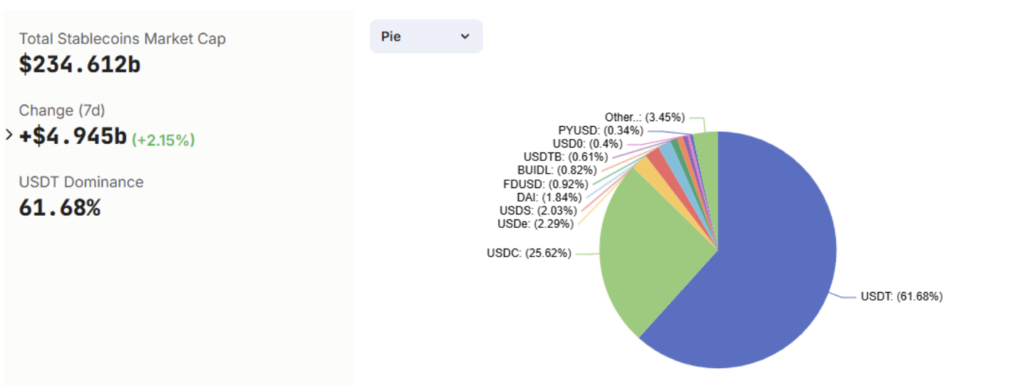
With new stablecoins emerging and competing to replace USDT and USDC, the race is increasing. CZ, the former CEO of Binance, is of the opinion that competition will only add dynamism to the market.
CZ commented on social media,
“No need to replace. The more, the merrier.”
Yet, it is not just crypto-native companies entering the market. Traditional financial institutions and fintech firms like PayPal, Custodia bank, and Vantage bank are also joining the space.
Interestingly, World Liberty Financial, a project backed by the Trump family, announced its USD1 stablecoin on March 25, 2025. The project raised $500 million within a few months, outlining the growing interest in stablecoins from political and financial parties.
Closing Remark
BTC has grown into an institutional-level asset, depicted by resilience and long-term growth instead of large surges. While its ROI no longer corresponds to early bull runs, it consistently outperforms traditional assets.
Moreover, with the SEC taking a more relaxed stance lately, through proper allocation and risk management, BTC can remain a valuable portfolio asset in the DeFi landscape in the long term.
The five economic events listed are worth checking out during this crypto week. As an enthusiast, trader or investor, they are worth studying.
Zypto App Integrates Raydium
Zypto has integrated Raydium, Solana’s liquidity provider, into Zypto App. You can now easily trade Solana-based tokens with deep liquidity, ultra-fast transactions and low fees. Find out more here.
There’s so much to look out for this week – from BTC to stablecoins to economic events. What do you think about it all? Let’s know in the comments section.

FAQs
What is Bitcoin’s ROI in the current cycle?
BTC has a 560% ROI in the current 2022-2025 cycle.
What led to the value of Bitcoin’s ROI?
Although a downtrend from previous cycles, Bitcoin’s ROI shows the asset’s increasing liquidity, institutional adoption, and stable growth.
What new feature did Binance implement?
Binance has moved from large-scale initial token offerings to a secondary listing model.
What are the economic events that can influence crypto this week?
They include, services and manufacturing PMI, consumer confidence, initial job claims, GDP, and PCE index.
What does Fidelity Investments plan to do?
Fidelity plans to launch its stablecoin soon.
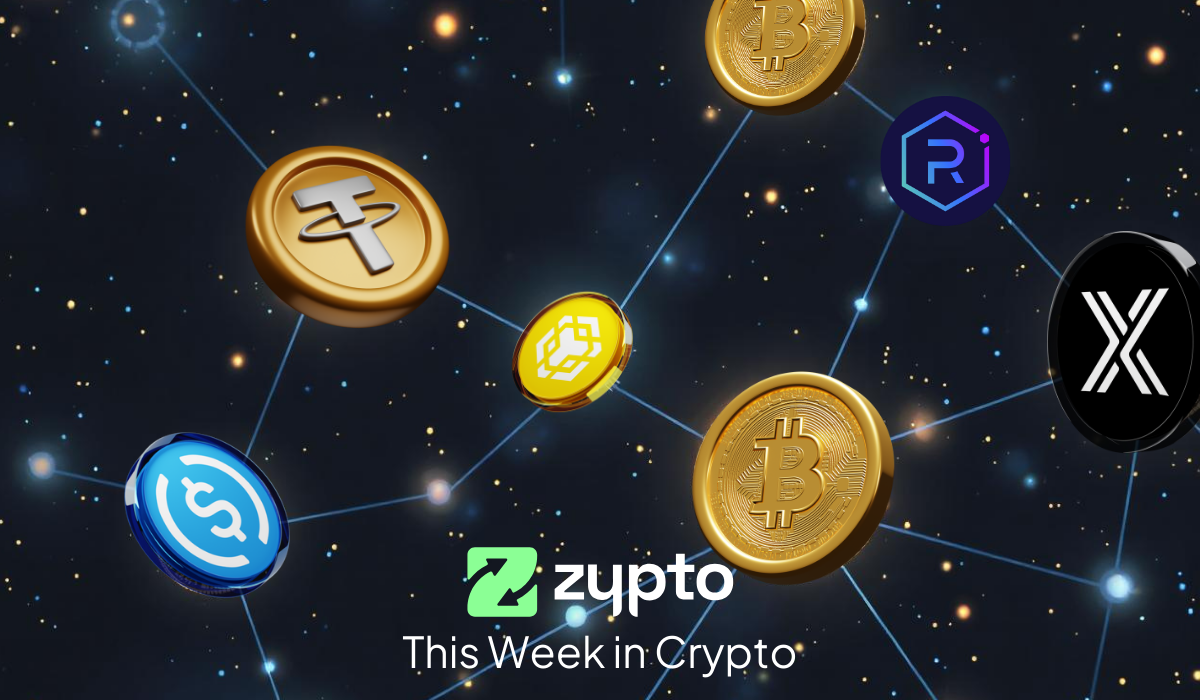


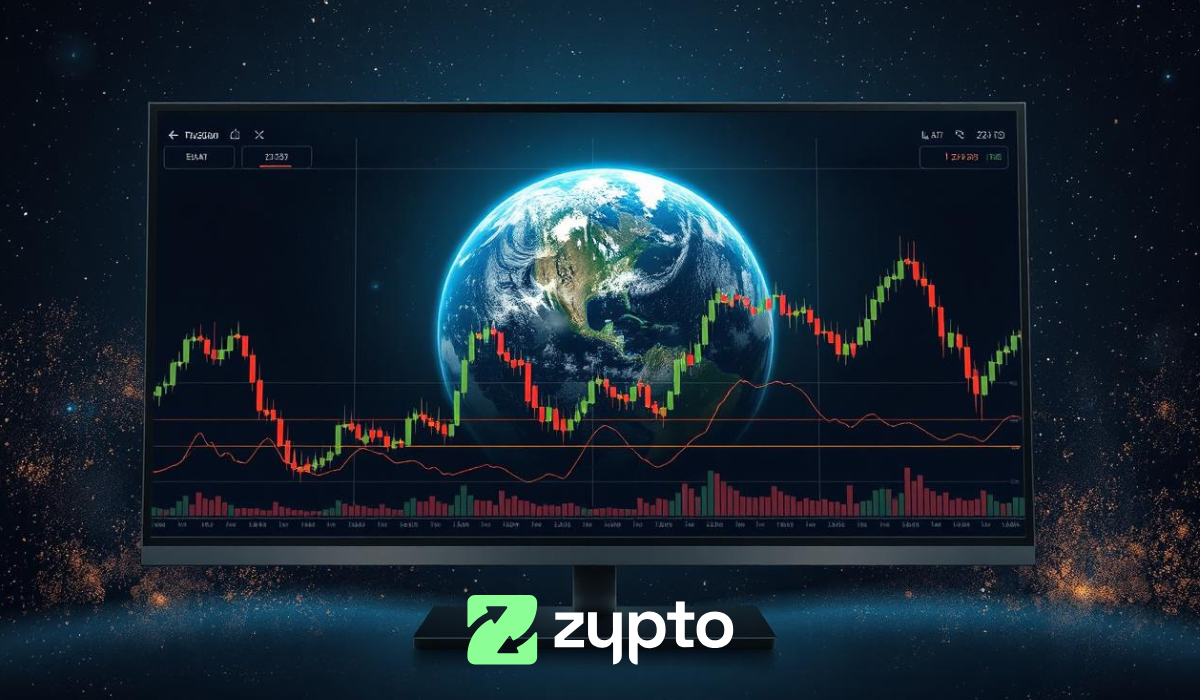


















Incredible update from Zypto! The Raydium integration is a great swap feature for all solana token traders. Definitely use this feature by swapping by solana token soon
nice overview of current events without being too technical
Having tried the raydium.io integration on Zypto app I can only say well done, so easy, smooth and intuitiv. good app!
Zypto is proving once again why Zypto is a leader in the cryptocurrency. The Raydium integration for all SOLANA Blockchain tokens is a great idea that they made for us.